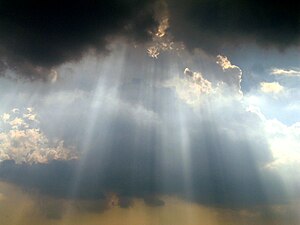During the day the Sun can be seen in the sky, unless obscured by clouds. In the night sky (and to some extent during the day) the moon, planets and stars are visible in the sky. Some of the natural phenomena seen in the sky are clouds, rainbows, and aurorae. Lightning and precipitation can also be seen in the sky during storms. On Earth, birds, insects, aircraft, and kites are often considered to fly in the sky. As a result of human activities, smog during the day and light radiance during the night are often seen above large cities (see also light pollution).
See extraterrestrial skies for descriptions of the skies of various planets and moons in the solar system.
Light from the sky is a result of the scattering of sunlight, which results in a blue color perceived by the human eye. On a sunny day Rayleigh scattering gives the sky a blue gradient — dark in the zenith, light near the horizon. Light that comes in from overhead encounters 1/38th of the air mass that light coming along a horizon path encounters. So, fewer particles scatter the zenith sunbeam, and therefore the light remains a darker blue. The blueness is at the horizon because the blue light coming from great distances is also preferentially scattered. This results in a red shift of the far lightsources that is compensated by the blue hue of the scattered light in the line of sight. In other words, the red light scatters also; if it does so at a point a great distance from the observer it has a much higher chance of reaching the observer than blue light. At distances nearing infinity the scattered light is therefore white. Far away clouds or snowy mountaintops will seem yellow for that reason; that effect is not obvious on clear days, but very pronounced when clouds are covering the line of sight reducing the blue hue from scattered sunlight. This can be observed at the bottom part of the picture on top of the article.
Another thing worth mentioning is that the scattering due to very small particles (molecule sized) is almost random. The scattering in a 90 degree angle is still half of the scattering that reflects or goes forward. This causes the blue sky to be almost evenly colored and thin clouds to form a white area around the sun, because the big particles the clouds are made of are scattering preferentially only at low angles. The color of the clouds is also due to scattering and a cloud at a small distance has the white color because all the light from these clouds is scattered multiple times in the mass of particles and no wavelength effects will be observed.
The sky can turn a multitude of colors such as red, orange, purple and yellow (especially near sunset or sunrise) and black at night. Scattering effects also partially polarize light from the sky, most pronounced at an angle 90° from the sun.
Sky luminance distribution models have been recommended by the International Commission on Illumination (CIE) for the design of daylighting schemes. Recent developments relate to "all sky models" for modelling sky luminance under weather conditions ranging from clear sky to overcast.
See extraterrestrial skies for descriptions of the skies of various planets and moons in the solar system.
Light from the sky is a result of the scattering of sunlight, which results in a blue color perceived by the human eye. On a sunny day Rayleigh scattering gives the sky a blue gradient — dark in the zenith, light near the horizon. Light that comes in from overhead encounters 1/38th of the air mass that light coming along a horizon path encounters. So, fewer particles scatter the zenith sunbeam, and therefore the light remains a darker blue. The blueness is at the horizon because the blue light coming from great distances is also preferentially scattered. This results in a red shift of the far lightsources that is compensated by the blue hue of the scattered light in the line of sight. In other words, the red light scatters also; if it does so at a point a great distance from the observer it has a much higher chance of reaching the observer than blue light. At distances nearing infinity the scattered light is therefore white. Far away clouds or snowy mountaintops will seem yellow for that reason; that effect is not obvious on clear days, but very pronounced when clouds are covering the line of sight reducing the blue hue from scattered sunlight. This can be observed at the bottom part of the picture on top of the article.
 Sky luminance and colors |  Sky |  sky « Wallpaper Pictures |  Sky WindPower Corporation |  Why is the Sky Blue? |
 The sky |  The SKY |  sky |  sky « My Blog |  skies |
Sky luminance distribution models have been recommended by the International Commission on Illumination (CIE) for the design of daylighting schemes. Recent developments relate to "all sky models" for modelling sky luminance under weather conditions ranging from clear sky to overcast.
 Filename: sky-33.jpg |  Filename: sky-04.jpg |  blue sky wallpaper |  sky golf: Dish TV DTH- Zee DTH |  Sky wallpaper |
 sky (newkon) |  It\x26#39;s a limitless sky. |  Picture of Big Blue Sky, |  U know why \x26#39;the sky\x26#39; is blue? |  Picture of Big Blue Sky, |
No comments:
Post a Comment